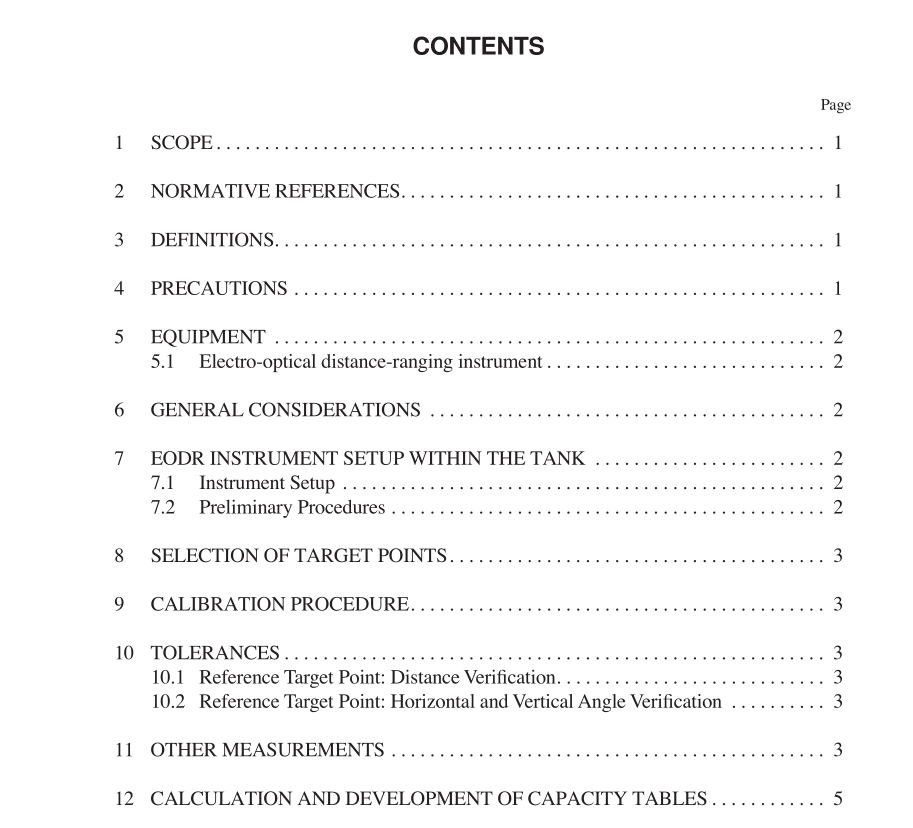API MPMS 2.2D pdf download

API MPMS 2.2D pdf download.Manual of Petroleum Measurements Standards
1 Scope
1.1 This part speciÞes a method for the calibration of upright cylindrical tanks having diameters greater than 5 m by means of internal measurements using an electro-optical distance-ranging instrument, and for the subsequent compila- tion of tank capacity tables. This method is known as the internal electro-optical distance-ranging (EODR) method. 1.2 This part of Chapter 2 is not applicable to the calibra- tion of abnormally deformed (e.g. dented) tanks or of noncir- cular tanks. 1.3 This part of Chapter 2 is applicable to tanks tilted by < or = 3 % from the vertical, provided a correction is applied for the measured tilt as described in Chapter 2.2A. 1.4 This part of Chapter 2 is applicable to tanks with cone- up or cone-down bottoms, as well as to tanks with ßat bot- toms.
3 Definitions
For the purposes of this part of Chapter 2 the deÞnitions given in API MPMS Chapter 2.2A and the following deÞni- tions apply. 3.1 reference target point: Fixed point clearly marked on the inside surface of the tank shell wall. 3.2 slope distance: Distance measured from the electro- optical distance-ranging instrument to a target point on any given course of the tank shell wall. 3.3 target point: One of a series of points on the inside surface of the tank shell wall to which slope distance, vertical and horizontal angles are measured by use of the electro-opti- cal ranging instrument.
4 Precautions
The general and safety precautions contained in API MPMS Chapter 2.2A shall apply to this standard. In addition, the laser beam emitted by the distance-ranging unit shall conform to IEC 825 for a class 1 laser.
5 Equipment
5.1 ELECTRO-OPTICAL DISTANCE-RANGING INSTRUMENT 5.1.1 The angular measuring part of the instrument shall have an angular graduation and resolution equal to or better than ± 0.0002 gon*, a repeatability equal to or better than ± 0.0005 gon, and an uncertainty equal to or better than ± 0.001 gon. 2 . 5.1.2 The distance-measuring part of the instrument, used for direct determination of the distances, shall have a gradua- tion and resolution equal to or better than ± 1 mm, a repeat- ability equal to or better than ± 2 mm, and an uncertainty equal to or better than ± 2 mm. 5.2 INSTRUMENT MOUNTING consisting of a tripod which is Þrm and stable. The legs of the tripod shall be held Þrm, and steadied by suitable devices such as magnetic bearers. 5.3 LASER BEAM EMITTER having a low-power laser beam complying with IEC 825, which is either an integral part of the EODR instrument or a separate device. If the laser beam emitter is a separate device, it may be Þtted with a Þber optic light transmitter system and a theodolite telescope eye- piece connection, by which the laser beam may be transmit- ted through a theodolite, or such that it may be Þtted to a theodolite with its axis parallel to the axis of the theodolite. The laser beam may be coincident with the optical axis of the telescope Note 1: The laser beam emitter is used to position target points on the tank shell. 5.4 STADIA a rigid bar, usually 2 m long, such that the graduated length between the two stadia marks remains con- stant to within ± 0.02 mm.
7 EODR Instrument Setup Within the Tank
7.1 INSTRUMENT SETUP 7.1.1 The instrument shall be set up with care, according to the procedure and instructions given by the manufacturers. 7.1.2 The instrument shall be set up so as to be stable. If necessary, the tank bottom in the vicinity of the instru- ment shall be made Þrm and steady by placing heavy weights in the area. The legs of the tripod on which the instrument is mounted shall be steadied by use of suitable devices, such as magnetic bearers, to prevent slippage on the tank bottom. 7.1.3 The instrument shall be located at, or near, the center of the tank. Note 4: This will ensure that the measured slope distances, at any one horizontal level, do not vary signiÞcantly and minimizes the overall uncertainty of slope distance determination. 7.1.4 The instrument shall be set horizontal, thus ensuring that the vertical axis (standing axis) is vertical. 7.1.5 The instrument shall be free from external vibration. 7.1.6 The sighting lines from the instrument to the tank shell wall shall not be obstructed.









